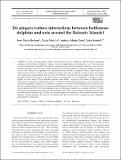Files in this item
Do pingers reduce interactions between bottlenose dolphins and nets around the Balearic Islands?
Item metadata
| dc.contributor.author | Brotons, J.M. | |
| dc.contributor.author | Munilla, Z | |
| dc.contributor.author | Grau, A.M. | |
| dc.contributor.author | Rendell, Luke Edward | |
| dc.date.accessioned | 2013-07-26T09:01:04Z | |
| dc.date.available | 2013-07-26T09:01:04Z | |
| dc.date.issued | 2008 | |
| dc.identifier | 409216 | |
| dc.identifier | 733349c0-971b-4e11-98e4-5ae0eb65a1c6 | |
| dc.identifier | 55449129606 | |
| dc.identifier.citation | Brotons , J M , Munilla , Z , Grau , A M & Rendell , L E 2008 , ' Do pingers reduce interactions between bottlenose dolphins and nets around the Balearic Islands? ' , Endangered Species Research , vol. 5 , no. 2-3 , pp. 301-308 . https://doi.org/10.3354/esr00104 | en |
| dc.identifier.issn | 1863-5407 | |
| dc.identifier.other | standrews_research_output: 24490 | |
| dc.identifier.other | ORCID: /0000-0002-1121-9142/work/27612567 | |
| dc.identifier.uri | https://hdl.handle.net/10023/3879 | |
| dc.description.abstract | The artisanal gillnet fishery around the Balearic Islands is experiencing a growing problem with bottlenose dolphins Tursiops truncatus depredating the bottom-set nets. The resulting catch loss engenders hostility from fishers, and interactions between dolphins and nets can result in bycatch mortality. One potential mitigation measure is the placement of acoustic alarms, or pingers, on the nets. However, as pingers have produced mixed results in studies of their effectiveness in other fisheries, direct evidence is needed on whether they will be effective in this fishery. We report on a large-scale experimental trial in which 59 different vessels from the artisanal fleet were each equipped with identical nets, and each vessel was assigned to 1 of 3 conditions: no pinger, inactive pinger or active pinger. Three brands of pinger were tested. During the trial, data on fishing operations were recorded by onboard observers. A total of 1193 fishing operations were observed. We analysed 2 response variables, the presence or absence of evidence that dolphins had interacted with the net, and standardized yields, using generalized linear mixed models. Overall net interaction rates were reduced by 49% with active pingers, but not all pinger brands were equally effective. Yields, measured as profit per unit effort, were increased by 9% in the active-pinger condition, but this was not statistically significant (p = 0.592). Our results suggest that pingers in the artisanal fisheries of the Balearic Islands reduced the rate of net interaction, but further study is required given dolphins’ potential for habituation. | |
| dc.format.extent | 247325 | |
| dc.language.iso | eng | |
| dc.relation.ispartof | Endangered Species Research | en |
| dc.subject | Pingers | en |
| dc.subject | Gillnet | en |
| dc.subject | Bottlenose dolphin | en |
| dc.subject | Balearics | en |
| dc.subject | Bycatch | en |
| dc.subject | QL Zoology | en |
| dc.subject.lcc | QL | en |
| dc.title | Do pingers reduce interactions between bottlenose dolphins and nets around the Balearic Islands? | en |
| dc.type | Journal article | en |
| dc.contributor.institution | University of St Andrews. School of Biology | en |
| dc.contributor.institution | University of St Andrews. Bioacoustics group | en |
| dc.contributor.institution | University of St Andrews. Centre for Social Learning & Cognitive Evolution | en |
| dc.identifier.doi | https://doi.org/10.3354/esr00104 | |
| dc.description.status | Peer reviewed | en |
| dc.identifier.url | http://www.scopus.com/inward/record.url?scp=55449129606&partnerID=8YFLogxK | en |
| dc.identifier.url | http://www.int-res.com/abstracts/esr/bycatch/bycatchpp8/ | en |
This item appears in the following Collection(s)
Items in the St Andrews Research Repository are protected by copyright, with all rights reserved, unless otherwise indicated.

